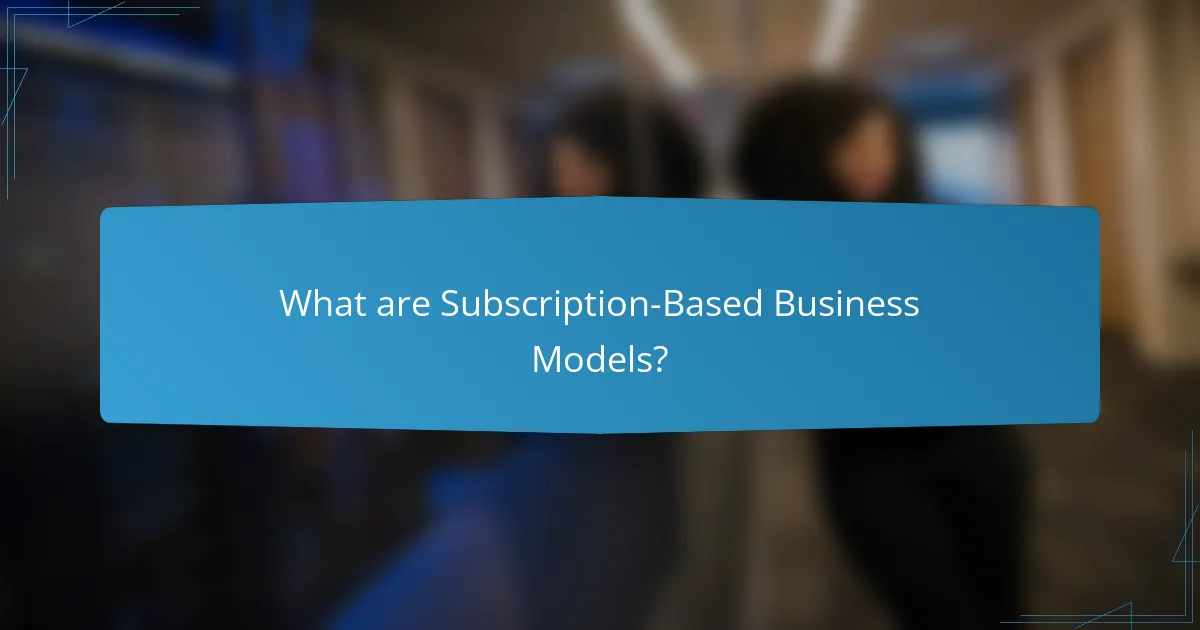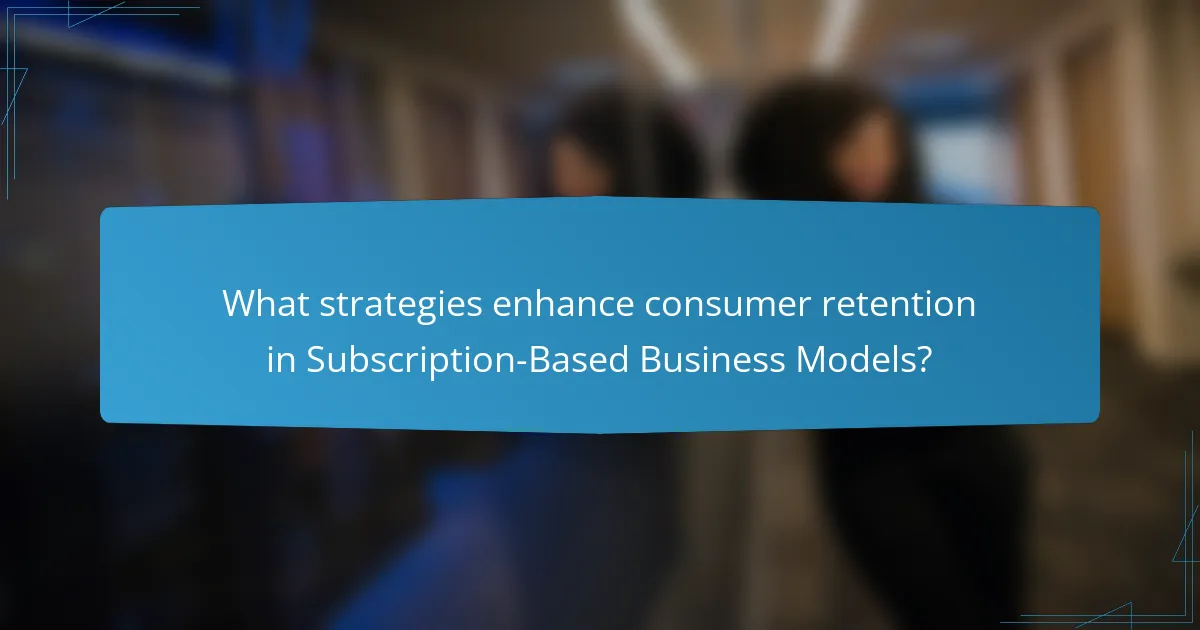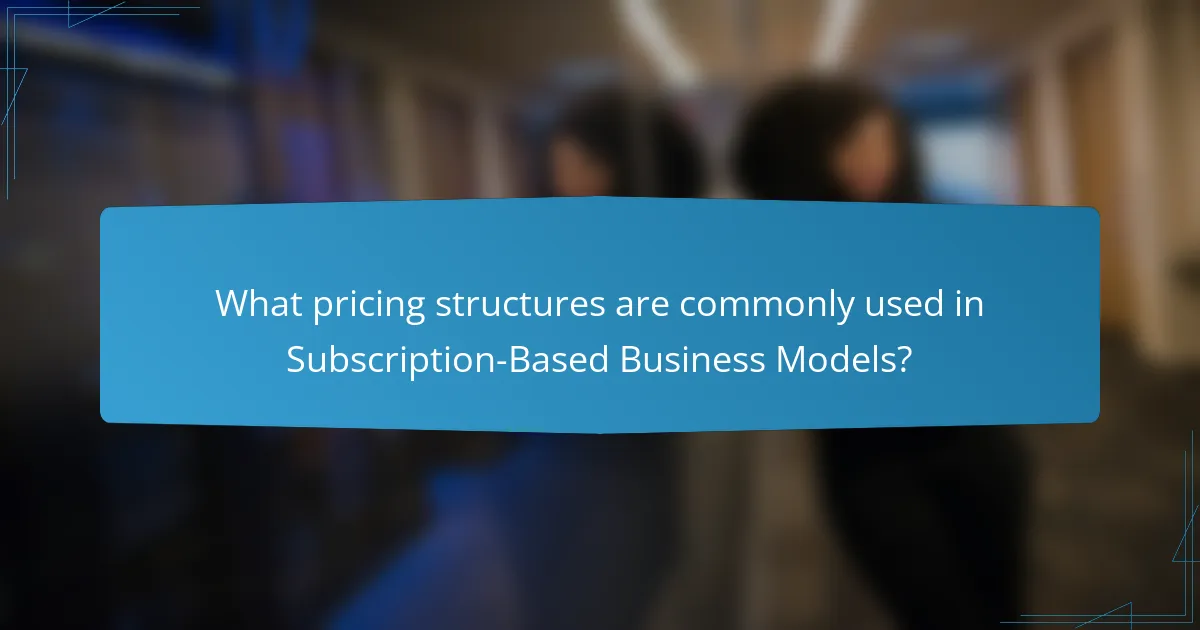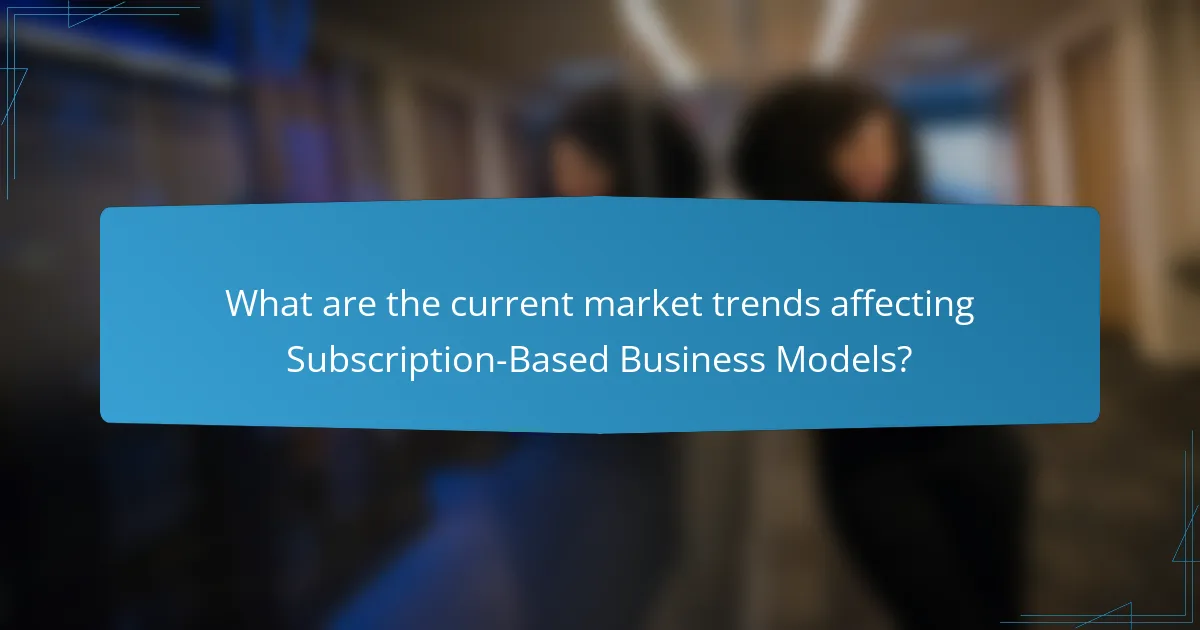Subscription-based business models are revenue structures where customers pay a recurring fee for access to products or services, applicable across various industries such as software, media, and consumer goods. This model promotes a steady income stream for businesses while providing customers with convenience and lower upfront costs. Key strategies for enhancing consumer retention in these models include personalization through data analytics, flexible pricing structures like flat-rate and tiered pricing, and effective loyalty programs. Current market trends emphasize the importance of tailored experiences, adaptability in pricing, and ongoing engagement to meet evolving consumer expectations. Research indicates that implementing these strategies can significantly boost retention rates and overall business growth.

What are Subscription-Based Business Models?
Subscription-based business models are revenue structures where customers pay a recurring fee for access to products or services. This model ensures a steady stream of income for businesses. It can apply to various industries, including software, media, and consumer goods. Customers benefit from convenience and often lower upfront costs. According to a 2020 study by Zuora, subscription businesses grew nearly five times faster than traditional businesses. This growth indicates a shift in consumer preferences towards subscription services. Such models enhance customer retention through ongoing engagement and value delivery.
How do Subscription-Based Business Models operate?
Subscription-based business models operate by providing customers access to products or services for a recurring fee. Customers typically pay on a monthly or annual basis. This model ensures a steady revenue stream for businesses. It often involves tiered pricing structures to cater to different customer needs. Businesses may offer free trials to attract new subscribers. Retention strategies are crucial, as keeping existing customers is often cheaper than acquiring new ones. Data analytics are used to understand customer behavior and preferences. Companies can adjust offerings based on usage patterns and feedback. This adaptability enhances customer satisfaction and loyalty.
What are the key components of a Subscription-Based Business Model?
The key components of a Subscription-Based Business Model include recurring revenue, customer engagement, and service delivery. Recurring revenue is generated through regular subscription fees paid by customers. Customer engagement involves maintaining relationships with subscribers to enhance retention. Service delivery ensures that the product or service is provided consistently and meets customer expectations. These components work together to create a sustainable business model. For instance, a study by Zuora found that subscription businesses grow revenue 5 to 8 times faster than traditional businesses, highlighting the effectiveness of these components.
How do these components interact to create value?
Subscription-based business models create value through the interaction of consumer retention strategies, pricing structures, and market trends. Consumer retention strategies enhance loyalty by providing ongoing engagement and personalized experiences. Pricing structures, such as tiered plans, cater to diverse customer needs and maximize revenue potential. Market trends inform businesses about consumer preferences and competitive positioning, allowing for strategic adjustments. Together, these components foster a sustainable revenue stream and improve customer satisfaction. For instance, a study by McKinsey & Company found that companies with effective retention strategies can increase customer lifetime value by 25% to 95%.
What are the different types of Subscription-Based Business Models?
There are several types of subscription-based business models. These include the following:
1. Flat-rate subscription model: This model charges a fixed fee for access to a service or product over a specified period. It is commonly used in streaming services like Netflix.
2. Tiered subscription model: This model offers multiple pricing levels with varying features. An example is software services that provide different functionalities at different price points.
3. Usage-based subscription model: This model charges users based on their consumption. This is seen in cloud services like AWS, where fees depend on usage levels.
4. Freemium model: This model provides basic services for free while charging for premium features. Popular examples include LinkedIn and Spotify.
5. Membership model: This model charges a recurring fee for access to exclusive content or community benefits. Examples include gyms and professional organizations.
6. Product subscription model: This model delivers physical products on a regular basis. Examples include subscription boxes like Birchbox or Dollar Shave Club.
7. Hybrid model: This model combines elements of different subscription types. For instance, a service may offer a flat rate with additional usage fees.
Each model has distinct characteristics and appeals to different consumer needs, contributing to their popularity in various industries.
How do product-based subscriptions differ from service-based subscriptions?
Product-based subscriptions provide physical goods, while service-based subscriptions offer intangible services. In product-based subscriptions, consumers receive items like food, clothing, or electronics on a regular basis. For example, companies like Dollar Shave Club deliver razors monthly. In contrast, service-based subscriptions include offerings like streaming services or software access. Netflix is a prime example, providing access to movies and shows for a monthly fee.
The key difference lies in the nature of delivery. Product-based subscriptions focus on tangible items, while service-based subscriptions emphasize ongoing access to services. This distinction affects customer expectations and business models. Product-based models often require inventory management. Service-based models prioritize content or service delivery efficiency. Understanding these differences helps businesses tailor their strategies effectively.
What are the emerging trends in Subscription-Based Business Models?
Emerging trends in subscription-based business models include personalized offerings, flexible pricing, and enhanced customer engagement. Personalized offerings allow companies to tailor subscriptions based on individual customer preferences. Flexible pricing structures, such as tiered plans, cater to diverse consumer needs. Enhanced customer engagement strategies utilize data analytics to improve user experience. The rise of digital content consumption drives subscriptions in entertainment and education sectors. According to a 2022 McKinsey report, subscription services grew by 300% in the last five years. This growth highlights the increasing consumer preference for access over ownership.

What strategies enhance consumer retention in Subscription-Based Business Models?
Personalization enhances consumer retention in subscription-based business models. Tailoring offerings to individual preferences fosters a stronger connection with subscribers. Data analytics can identify user behavior and preferences, allowing businesses to customize content and recommendations. Implementing loyalty programs incentivizes continued subscriptions by rewarding long-term customers. Regular communication through newsletters and updates keeps subscribers engaged and informed. Offering flexible subscription options, such as pausing or modifying plans, increases satisfaction and reduces churn. Providing exceptional customer service builds trust and encourages subscribers to remain loyal. Research indicates that retention rates can increase by up to 30% with effective personalization strategies.
How can businesses improve customer engagement?
Businesses can improve customer engagement by personalizing communication and interactions. Tailored messages resonate better with consumers. Utilizing data analytics allows businesses to understand customer preferences. This understanding fosters relevant content delivery. Engaging customers through social media enhances brand visibility. Regular interactions on these platforms build community and loyalty. Implementing loyalty programs incentivizes repeat purchases. Research shows that 70% of consumers prefer brands that offer personalized experiences. Creating feedback loops encourages customer input and shows that their opinions matter. This two-way communication strengthens relationships and boosts satisfaction.
What role does personalization play in consumer retention?
Personalization significantly enhances consumer retention by creating tailored experiences for individuals. It allows businesses to address specific needs and preferences of their customers. This customization fosters a sense of connection and loyalty. According to a study by Epsilon, 80% of consumers are more likely to make a purchase when brands offer personalized experiences. Additionally, personalized recommendations can increase conversion rates by up to 300%. This shows that effective personalization strategies lead to higher customer satisfaction and repeat purchases. Ultimately, personalization is a crucial factor in retaining consumers in subscription-based business models.
How can feedback mechanisms strengthen customer loyalty?
Feedback mechanisms can strengthen customer loyalty by enabling businesses to understand and address customer needs effectively. When customers provide feedback, they feel valued and heard. This engagement fosters a sense of community and connection with the brand. Companies that actively respond to feedback can make necessary improvements to their products or services. According to a study by Bain & Company, businesses that prioritize customer feedback see a 10-15% increase in customer retention rates. Additionally, addressing concerns raised through feedback can prevent churn and enhance overall satisfaction. By implementing changes based on customer input, businesses demonstrate commitment to their customers, reinforcing loyalty over time.
What are the most effective methods for reducing churn?
The most effective methods for reducing churn include improving customer engagement, offering personalized experiences, and implementing proactive customer support. Engaging customers through regular communication increases their connection to the brand. Personalized experiences, such as tailored recommendations, enhance user satisfaction. Proactive customer support addresses issues before they escalate, reducing dissatisfaction.
Research shows that companies with high engagement levels see a 30% decrease in churn rates. Additionally, 80% of consumers are more likely to continue using a service if they receive personalized interactions. Implementing these strategies can significantly lower churn and improve overall retention rates.
How can businesses identify at-risk subscribers?
Businesses can identify at-risk subscribers by analyzing engagement metrics and subscription patterns. Key indicators include reduced usage frequency and declining interaction with content. Monitoring churn rates can also highlight potential risks. Implementing surveys to gather feedback provides insights into subscriber satisfaction. Tracking payment failures or missed renewals signals financial disengagement. Analyzing customer support interactions can reveal dissatisfaction trends. Utilizing predictive analytics can forecast subscriber behavior based on historical data. These methods collectively help businesses proactively address subscriber retention.
What retention tactics can be implemented to keep subscribers?
To keep subscribers, businesses can implement personalized communication. Tailoring messages to individual preferences increases engagement. Offering exclusive content or discounts also enhances subscriber loyalty. Regularly soliciting feedback shows customers their opinions matter. Implementing a referral program encourages current subscribers to bring in new ones. Creating a community around the service fosters a sense of belonging. Additionally, providing a seamless user experience reduces churn. Research indicates that personalized experiences can boost retention rates by up to 20%.

What pricing structures are commonly used in Subscription-Based Business Models?
Common pricing structures in subscription-based business models include flat-rate, tiered, per-user, and usage-based pricing. Flat-rate pricing charges a single fee for access to all services. This model simplifies budgeting for consumers. Tiered pricing offers multiple plans at different price points. Each tier provides varying levels of service or features. Per-user pricing charges based on the number of users accessing the service. This structure is popular in software subscriptions. Usage-based pricing charges consumers based on their actual usage of the service. This model aligns costs with consumption. These pricing structures help businesses cater to diverse consumer needs and preferences.
How do different pricing strategies impact consumer behavior?
Different pricing strategies significantly influence consumer behavior. For instance, psychological pricing, such as pricing an item at $9.99 instead of $10, can lead to increased sales. This strategy leverages the perception of value and encourages impulse purchases.
Additionally, tiered pricing can affect consumer choices. Offering multiple subscription levels allows consumers to select a plan that fits their budget. Research shows that consumers are more likely to subscribe when presented with several options.
Promotional pricing also plays a critical role. Temporary discounts or limited-time offers can create urgency, prompting quicker purchasing decisions. A study by the Journal of Marketing found that promotional pricing can increase sales volume by up to 30%.
Moreover, value-based pricing aligns the product price with perceived consumer benefits. When consumers believe they receive more value, they are more likely to engage and remain loyal.
In summary, various pricing strategies directly shape consumer perceptions, choices, and purchasing behaviors.
What are the advantages of tiered pricing models?
Tiered pricing models offer several advantages for businesses. They allow companies to cater to diverse customer needs. By providing multiple pricing levels, businesses can attract a wider audience. This model encourages customers to upgrade for better features. It also enhances perceived value through differentiated offerings. Additionally, tiered pricing can lead to increased revenue. A study by McKinsey found that companies utilizing tiered pricing saw revenue growth of up to 20%. Furthermore, it enables businesses to segment customers based on willingness to pay. This segmentation can optimize pricing strategies and improve customer satisfaction.
How does dynamic pricing affect subscription service profitability?
Dynamic pricing can significantly enhance subscription service profitability. It allows companies to adjust pricing based on demand, competition, and customer behavior. This flexibility can lead to increased revenue during peak demand periods. For example, a study by McKinsey found that dynamic pricing can boost profits by 10-30%. Additionally, it helps in customer segmentation by offering tailored pricing to different user groups. This approach can improve customer retention by providing perceived value. However, if not managed carefully, it may risk alienating some customers. Overall, when implemented strategically, dynamic pricing can optimize both revenue and customer satisfaction in subscription services.
What are the implications of freemium models in subscriptions?
Freemium models in subscriptions offer both opportunities and challenges for businesses. They attract a large user base by providing free access to basic features. This can lead to increased brand awareness and customer acquisition. However, conversion rates from free to paid tiers are often low. Research shows that typically only 2-5% of freemium users convert to paying customers.
Freemium models require careful balancing of free and premium offerings. Companies must ensure that free features are compelling enough to attract users but not so comprehensive that they dissuade upgrades. Additionally, customer retention can be affected by user experience. Users may disengage if they perceive the premium features as not worth the cost.
Businesses must also consider the costs associated with maintaining a large free user base. Support and infrastructure can strain resources if not managed properly. Overall, while freemium models can drive growth, they necessitate strategic planning and execution to be successful.
How can freemium models convert free users into paying subscribers?
Freemium models convert free users into paying subscribers by offering additional features or benefits that enhance user experience. These models typically provide a basic version for free while charging for premium features. This strategy allows users to experience the product’s value before committing financially.
Incentives such as time-limited trials of premium features can encourage upgrades. For instance, offering a one-month free access to premium features can create urgency. Additionally, personalized marketing and targeted promotions can effectively convert users.
Research indicates that 2-5% of freemium users typically convert to paid plans, depending on the industry. Companies like Spotify and LinkedIn successfully use this model, showcasing its effectiveness in driving subscriptions.
What challenges do freemium models face in terms of retention?
Freemium models face significant challenges in retaining users. Users often disengage after initial use due to limited features. The lack of compelling incentives to upgrade can lead to stagnation. Additionally, users may find alternative solutions that offer better value. High competition in the market exacerbates retention issues. Many users do not perceive enough value in premium offerings. This perception leads to decreased motivation to convert from free to paid. A study by Reicheld and Schefter indicates that only 1-5% of freemium users typically convert to paid plans. Thus, retention remains a critical hurdle for freemium models.

What are the current market trends affecting Subscription-Based Business Models?
Current market trends affecting subscription-based business models include increased personalization, flexible pricing strategies, and a focus on customer retention. Personalization enhances user experience and engagement. Companies utilize data analytics to tailor offerings to individual preferences. Flexible pricing models, such as tiered subscriptions, cater to diverse consumer needs. This adaptability can lead to higher conversion rates. Customer retention strategies are becoming essential as competition grows. Businesses are investing in loyalty programs and exclusive content to keep subscribers engaged. According to a 2023 report by McKinsey, 75% of consumers expect brands to offer personalized experiences. This trend highlights the importance of understanding consumer behavior in subscription services.
How has consumer behavior shifted in the subscription economy?
Consumer behavior in the subscription economy has shifted towards a preference for flexibility and personalization. Many consumers now seek subscription services that offer customizable options. This trend reflects a desire for tailored experiences that fit individual needs. According to a 2021 survey by McKinsey, 71% of consumers reported that they prefer subscriptions that allow them to adjust their plans. Additionally, there is a growing interest in subscription models that provide value through added convenience. Research by Statista indicates that 64% of consumers are more likely to subscribe if they perceive a clear benefit. The rise of digital platforms has also contributed to this shift, as consumers increasingly engage with services via mobile devices. Overall, these changes indicate a demand for more engaging and user-centric subscription offerings.
What role does technology play in shaping market trends?
Technology plays a crucial role in shaping market trends. It drives innovation and alters consumer behavior. For example, advancements in data analytics enable businesses to understand consumer preferences better. This understanding allows for more targeted marketing strategies. Additionally, technology facilitates the development of subscription-based models, which cater to changing consumer demands. According to a report by McKinsey, over 60% of consumers are open to subscription services. This shift indicates a significant trend influenced by technological advancements. Furthermore, technology enhances customer engagement through personalized experiences and streamlined communication. Thus, technology is integral in defining and evolving market trends.
How do demographic changes influence subscription service offerings?
Demographic changes significantly influence subscription service offerings by altering consumer preferences and needs. For instance, an aging population may increase demand for health-related subscriptions. Younger demographics often prefer on-demand entertainment and digital services. Changes in income levels can affect pricing strategies and service accessibility. Diverse cultural backgrounds lead to varied content preferences and service customization. Data from the U.S. Census Bureau shows that millennials and Gen Z are driving growth in streaming services. This demographic shift encourages companies to innovate and adapt their offerings accordingly. Subscription services must analyze demographic trends to remain competitive and relevant.
What future predictions can be made for Subscription-Based Business Models?
Subscription-based business models are expected to grow significantly in the coming years. Research indicates that the global subscription economy is projected to reach $1.5 trillion by 2025. This growth is driven by increasing consumer preference for convenience and personalized services. Companies will likely adopt more flexible pricing structures to attract a broader audience. Additionally, enhanced data analytics will enable businesses to tailor offerings to individual customer needs. As competition intensifies, companies may also focus on improving customer retention strategies. The rise of digital content consumption will further fuel subscription model adoption across various industries. Overall, these trends suggest a robust future for subscription-based models.
How might subscription services evolve in the next decade?
Subscription services will likely evolve to include more personalized offerings. Consumers increasingly demand tailored experiences that fit their preferences. Advanced data analytics will enable companies to understand customer behavior better. This will lead to dynamic pricing models based on individual usage patterns. Companies may also bundle services to provide greater value. The rise of AI and automation will streamline service delivery and enhance user experience. Additionally, subscription models may expand beyond traditional sectors into areas like healthcare and education. These trends indicate a shift towards more integrated and user-centric subscription experiences.
What innovations are expected to disrupt the subscription market?
Innovations expected to disrupt the subscription market include advanced personalization technologies, blockchain for transparency, and flexible pricing models. Advanced personalization leverages AI to tailor offerings based on consumer behavior. This can increase customer satisfaction and retention rates. Blockchain technology enhances security and trust in transactions. It allows for transparent tracking of subscriptions and payments. Flexible pricing models, such as pay-per-use or tiered subscriptions, cater to diverse consumer needs. These innovations are supported by industry trends indicating a shift towards more customer-centric approaches. According to a 2023 report by McKinsey, personalized experiences can lead to a 20% increase in customer loyalty.
What best practices should businesses follow to succeed in Subscription-Based Business Models?
Businesses should focus on customer experience, value delivery, and flexible pricing to succeed in subscription-based models. Prioritizing customer experience builds loyalty and reduces churn. Providing consistent value ensures customers feel they are receiving benefits from their subscription. Implementing flexible pricing options attracts a broader audience and accommodates different budgets. Regularly analyzing customer feedback helps refine offerings and improve satisfaction. Utilizing data analytics can identify trends and inform strategic decisions. Offering personalized content or services enhances engagement and retention. Finally, maintaining clear communication about changes in pricing or services fosters trust with subscribers.
Subscription-based business models are revenue structures where customers pay recurring fees for products or services, ensuring a steady income for businesses across various industries. This article explores the operation of these models, highlighting key components such as recurring revenue, customer engagement, and service delivery. It examines different types of subscription models, including flat-rate, tiered, and freemium, and discusses consumer retention strategies, pricing structures, and emerging market trends that impact subscription services. Additionally, the article analyzes how personalization and technology influence consumer behavior and the future of subscription-based models.